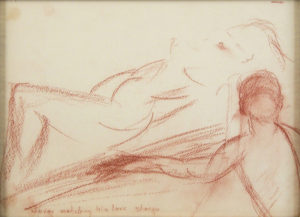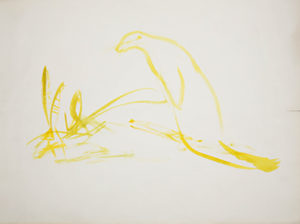Marilyn Monroe died over 54 years ago, but the culture vultures are still circling her crypt, eyeing the last unturned scraps of her life and career for commercial pickings. But, as the bits of relevant material lessen to nothingness, what is left really, to take from the corpse of an over-examined life? Well, Julien’s Auctions is more than happy to answer that question, because it turns out that Monroe was more than just an actor; she was, brace yourself, also an artist! And to prove that point, Julien’s is putting eleven unsigned Conté crayon drawings and watercolor paintings by Monroe up for auction. Although not much is left from previous auctions of the collection of personal effects that the actor bequeathed to her acting coach, Lee Strasberg, a recently discovered series of letters from the late 1950s reveal that Monroe was enrolled in a correspondence art course through the Famous Artists Schools in Westport, Connecticut. Apparently, this scholastic endeavor, coupled with the drawings currently up for auction, resolves any doubts about her seriousness as an artist. And, according to Monroe collector and historian Scott Fortner, “She did refer to herself as an artist – acting was her art – but she also expanded out to other areas of the arts.”

Lover Watching His Lover Sleep
Well, OK; but what else can be said about drawings that look more like something from a Life Drawing 101 class than manifestations of artistic genius? Plenty apparently, for Laura Woolley, who catalogued the items in the Julien’s auction, states, “It’s really a common thing for people in one creative field to have an outlet in the visual arts as well.” But art made by celebrities who are famous for doing something else is always problematic; it’s easy to consider bad artistic technique to be a manifestation of their brilliance in the other field. The problem to me is that it’s completely unnecessary to drag in all this artspeak; the value of these drawings is in what they meant to the actor, not their final auction price. By putting these minor, yet intensely personal, pieces up for sale, the mercenary approach of Julien’s Auctions does Monroe’s artistic self-expression a great disservice. The reason that none of these drawings and paintings were signed is that they were never meant to be seen, let alone owned, by anyone else.

Untitled
The dress that Monroe wore when she sang a sultry “Happy Birthday Mr. President” to John F. Kennedy, is expected to sell for three million dollars when it comes up for auction later this month. So, I guess the last of these hearse-chasers will only hit the jackpot on the penny slots when her drawings and paintings go to the gavel as well; opening bid on the smallest drawing is a mere 750 dollars. With that kind of money in the balance, it makes no sense to hype her artwork as some indicator of previously unknown talent. But the capitalists at Julien’s Auctions don’t care why these pieces were made, so long as they deliver any amount of profit. The question it comes down to is age-old: what’s more important, the art itself or the name of the person who made it? That has no answer; but does it matter really, if one has figured out how to cash in on it?


